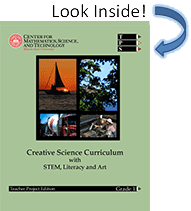First Grade Science 
What's the Matter?
This learning cycle involves several aspects of science content and processes in a fun and interesting manner. Students "dissect" a food item to determine what is in it. In the engineering context, this process would be called "reverse engineering." Students then conduct a few investigations to determine properties of each component. Through these activities, students are introduced to identification and measurement processes.
Rock Hard
This lesson has the potential to be a real mess, but the learning that will take place is worth the effort. Students will never forget making concrete. They will clearly understand how our natural world provides materials for useful products. They will gain experience in observations, measuring, and mixing. They will also see how fossils are formed, although this is not an educational standard for this level and is not emphasized in the activity.
Free to a Good Home
This lesson is quite rich and full of options. Students bring stuffed animals and arrange them into groups based on what species can live together. Initially this presents the opportunity to address "real" vs "fantasy" and "currently living" vs "extinct." Grouping the animals addresses an important scientific and mathematical skill of "classification." After determining needs, students create a backdrop to display their animals in an appropriate environment. This will require that they make plants, addressing the standard of parts of a plant. Students are also encouraged to include young offspring, requiring research on what the young species needs and what the "nest" might look like. This part of the activity can also be used to address life cycles of the species.
Formula M-1 Racing
This lesson is deceptively simple. It will also be very fun. Students build a racecar from cardboard and attach a metal binder clip to the bottom. This clip allows them to move the car on the racetrack by moving a magnet below. In doing so, they learn about magnets and motion. Light, heat, and sound energy are incorporated within the context of car racing.
Blown Away
Much of this standard can be addressed through observation and interaction with wind. Students make a simple anemometer (wind speed indicator) and take it outside for measurements. Students will also record other weather conditions. Perhaps students will discover a correlation between wind and other conditions peculiar to your location, such as "the wind is strongest on cloudy days" etc.
Looking Up
Several of your students will make up the earth and the rest will serve as the orbit of the moon as students model motion in our solar system. Student will then make a simple model of the earth and moon orbits.

